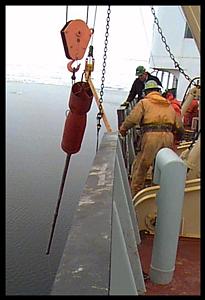7 September, 1997
Today will be our last coring station. We are in a region where no core
samples of the ocean floor have ever been collected. Previously, ships with
the special cranes and winches required for coring were not able to operate
in ice. This project required that the Louis be refitted to work as an
arctic research vessel.
There were two types of core samples collected today. The piston core
collected a section of sediment about six centimeters in diameter and three
meters long. The sediments from the bottom of the core were probably
deposited at a time when the arctic was free of ice. By studying these,
scientists will get a better idea of how the arctic responded at a time when
the planet was much warmer.
The second collection was made with a box corer, a device that scoops a
section of about one half square meter of the ocean bottom to a depth of
about 25 centimeters. This will be used to determine the sedimentation rate
and to measure the concentration of contaminants that are being transported
to the arctic.
There were several large stones on the top of the clay silt. We can only
speculate on their origin but assume they were carried on an ice flow. It
may just look like mud but it holds the recorded history of the area.

The first piston core collected in these waters
Contact the TEA in the field at
.
If you cannot connect through your browser, copy the
TEA's e-mail address in the "To:" line of
your favorite e-mail package.
|
